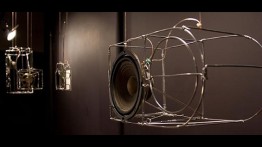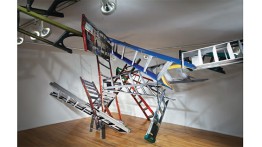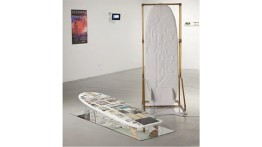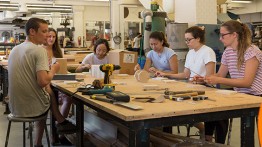Unsung Experts: Cooper Techs
POSTED ON: July 31, 2017
The students, faculty, and staff of The Cooper Union rely on the assistance of a group of largely unsung experts: lab, studio, and shop technicians. Students benefit from the knowledge and talent of the Cooper faculty as well as the technicians’ hands-on guidance in the fields of printing, woodworking, laser cutting, tooling, film, sound, video, photography, computing, casting, and a variety of other skills. Their expertise is not a surprise considering that many of Cooper’s techs are highly gifted artists in their own right. We sat down with four of them who are practicing artists to talk about their work both inside and outside The Cooper Union.
WAYNE ADAMS
 At Cooper, anyone with a Macintosh computer knows Wayne Adams, a network administrator and senior academic support specialist who focuses on issues associated with the Apple OS. Formerly a part of the School of Art working almost exclusively with art and architecture students, Adams and his colleagues—Marget Long, Lawrence Mesich, João Enxuto, Dennis Delgado, and Joyce Yu-Jean Lee—are now integrated into the broader IT department and give support to students, staff, and faculty campus-wide. All the support specialists are gifted artists, which “gives us a familiarity with the goals and projects of the students in all three schools,” Adams says. “On a given day I can be working on anything from AutoCAD to plotters.”
At Cooper, anyone with a Macintosh computer knows Wayne Adams, a network administrator and senior academic support specialist who focuses on issues associated with the Apple OS. Formerly a part of the School of Art working almost exclusively with art and architecture students, Adams and his colleagues—Marget Long, Lawrence Mesich, João Enxuto, Dennis Delgado, and Joyce Yu-Jean Lee—are now integrated into the broader IT department and give support to students, staff, and faculty campus-wide. All the support specialists are gifted artists, which “gives us a familiarity with the goals and projects of the students in all three schools,” Adams says. “On a given day I can be working on anything from AutoCAD to plotters.”
Adams’ own art doesn’t use computer technology; the Michigan native works primarily as a painter, making abstract images by layering materials—often paper and fake fur—on his canvas and deploying different types of mark-making. He uses tape to make controlled, linear marks and poured paint for a more organic effect. Sometimes he combines these with found religious imagery meant for children. “My personal background is heavily influenced by the conservative
Christian environment that I grew up in,” he says. While this didn’t play a part in his work in the past, he has started to address his upbringing more directly in his art. “I’m interested in how my own doubts and ideas about religion and Christianity have evolved and how they compare to the very quirky and specific Christian environment and culture I grew up in. That is further complicated in the process of making paintings.”
Adams’ artwork explores multiple patterns and materials so they frequently have a tactile quality. One of his exhibitions, Wayne Adams Is Speaking in Tongues: A Show of Objects and Images Organized by the Unrelenting Voice of Interpretation, includes, among many other pieces, four large canvases that are part of his Rift series—fake fur of varying colors divided by a precisely placed triangle of paint. At the room’s center is a wooden sculpture on wheels vaguely reminiscent of R2D2 in shape. It depicts Jesus sitting on top of a Thomas Kinkade blanket.
In 2007, Adams created a series of videos, Armor of God, in which he sports a cumbersome cardboard-and-foil suit. Looking like a DIY golem—but with a cross on his helmet—he tries to perform basic human physical tasks: walking down a flight of stairs or jumping into a pond. He generally fails. As one person off camera comments, “I think the greatest thing about this suit is that you can’t do anything with it.”
Currently he’s working on several pieces in his studio in the Gowanus section of Brooklyn. Against one wall is a painting with a fluorescent background, dots of spray paint and about half covered with a chevron pattern of tape. He plans to pour paint over the canvas, remove the tape, and then decide what needs to happen next. On another wall is a rough sketch painting of Martin Luther with a white silhouette of the Latin phrase “Sola Scriptura Scriptura Sola,” meaning “only scripture and scripture only.” The phrase summarizes a Christian doctrine, which asserts that the Bible alone provides guidance for the practice of faith. “At the moment I’m stuck with this, visually, but I like the idea of playing with this phrase, which a lot of Christians hold as something of a sacred truth—which I think is problematic.”
His exploration of the religious environment of his youth was in some ways precipitated by the birth of his two daughters. “I’ve started incorporating children’s religious education materials into my own paintings and have found both a more personal connection to the work and something of a deeper and more profound way of addressing religion and belief. I’ve also found a broader community of artists interested in the overlap of Christianity and art. In 2011 I joined the board of the 38-year-old organization Christians in the Visual Arts, where I volunteer as board chair. “All this is to say that I’ve become quite comfortable talking about religion in context with art—contemporary art specifically. I find there to be rich territory in exploring somewhat strange ideas of doubt and belief through the somewhat strange practice of making paintings, sculptures, and photographs.”
ZACH POFF
 Zach Poff, adjunct professor and technical assistant in film/video, finds exhibiting students’ work for the End of Year Show “bittersweet.” On the one hand, he wants to showcase the work of the students who took Projects in Sound Art, a course he’s taught since 2007. On the other hand, sound art often needs particular environments, ones that sometimes require greater space or context. “Many of the projects were created as installations,” he says. “They’re very difficult to include in a group show.” In a culture so geared toward the visual, finding literal and psychic space to listen is a central challenge to making sound art. Poff himself was initially studying photography and 16 mm filmmaking as a student at an arts high school in Baltimore.
Zach Poff, adjunct professor and technical assistant in film/video, finds exhibiting students’ work for the End of Year Show “bittersweet.” On the one hand, he wants to showcase the work of the students who took Projects in Sound Art, a course he’s taught since 2007. On the other hand, sound art often needs particular environments, ones that sometimes require greater space or context. “Many of the projects were created as installations,” he says. “They’re very difficult to include in a group show.” In a culture so geared toward the visual, finding literal and psychic space to listen is a central challenge to making sound art. Poff himself was initially studying photography and 16 mm filmmaking as a student at an arts high school in Baltimore.
He moved toward sound work through his time as a bass player with a band and increasingly exhibiting his photographs with an accompanying soundscape. His critics were frequently flummoxed by his presentations and largely ignored the aural aspect of his art. He sees Cooper students facing fewer challenges, but visual art still has a greater platform than work that engages other senses. That is understandable, he believes. “Most of us appreciate music, so we develop the skills to listen carefully and aesthetically, but our listening is very compartmentalized. We ignore most sounds to cope with a noisy world. In sound art we challenge ourselves to apply our listening skills outside music. Sometimes it can reveal things that are hidden by visual culture.”
Poff’s The Sound of The Sound of Music builds on that idea by taking a “common text”—the 1961 film version of the Rodgers and Hammerstein musical—and rearranging it based on pitch, not narrative. Similarly, for Video Silence, he wrote custom software to record very quiet moments from television shows. The program strings together a one-minute clip that is played on a loop until the system has culled another minute’s worth of quiet. Both pieces function as scaffolds that, as Poff puts it, “the world pours itself into.” This last point is critical to Poff, who is less interested in creating an artwork that is complete or self-contained than in making a new way to see and hear what already exists.
As part of his art practice, Poff teaches and lectures widely about the history of sound art as well as circuit bending, rewiring objects designed for one purpose—say, a Speak & Spell toy—to create unexpected sounds, often in a process that depends upon chance. One such work he created with N. B. Aldrich, Witnesses: Trikaya, is made up of a set of chanting boxes, inexpensive electronic devices that repeat Buddhist prayers to aid meditation. They have been wired to monitors showing the 1951 Chinese takeover of Tibet and subsequent uprisings in that
country. Initially the boxes are in sync, but almost immediately they produce sounds at different pitches in response to the violence on screen. Ironically, the boxes are manufactured in China. “The work that I do begins with questions as opposed to statements about the world around me. It’s important to me that my voice is not the only voice,” Poff says. “I consider my work pedagogical but I hope not dogmatic.”
JOE RILEY
 Joe Riley A’13 no longer takes classes, but as a technician working in the Printmaking & Type Shop, as well in the Sculpture Shop, he sees himself on a continuum, learning more about his craft and the community all the time. “I think of my work as a technician there not solely as a job, but also as a way to be within the school’s framework and an active member of the community. Which is just to say: I love Cooper Union.” Currently in the Whitney Independent Study Program, he notes how much of a Cooper education transpires in the sculpture shop, which he calls “a rich resource for students and one of the most actively used studio facilities in the entire school. Working in there was a formative experience for me as a student and now as a technician. I am glad to be a part of the critical processes of design, making, and working by hand—all central to Cooper’s pedagogical project.”
Joe Riley A’13 no longer takes classes, but as a technician working in the Printmaking & Type Shop, as well in the Sculpture Shop, he sees himself on a continuum, learning more about his craft and the community all the time. “I think of my work as a technician there not solely as a job, but also as a way to be within the school’s framework and an active member of the community. Which is just to say: I love Cooper Union.” Currently in the Whitney Independent Study Program, he notes how much of a Cooper education transpires in the sculpture shop, which he calls “a rich resource for students and one of the most actively used studio facilities in the entire school. Working in there was a formative experience for me as a student and now as a technician. I am glad to be a part of the critical processes of design, making, and working by hand—all central to Cooper’s pedagogical project.”
Riley, who also co-teaches the metalworking section of Introduction to Techniques, makes sculptures and prints in addition to creating sound installations, often with the intention of reviving an old idea to see it in a new light. “Missing details and faded characters fascinate me,” he writes of his art, “and in following them through my work I’ve picked up parallel histories of itinerant printers and abandoned railroads, Soviet bloc dictators and American soap opera cowboys, protests and pizza pulleys, free education, pirate radios, fake student IDs, and more. I craft material-driven works from such tellings, and with those works comes the hope of confronting political and poetic consciousness.”
He finds that older technologies often have a mythology attached to them. Trains, for instance, are greatly romanticized with myriad associated stories that he views as material for his art practice. His work “teases anecdotes out of stories and toward material form,” as he puts it. He finds that these artifacts—both physical and conceptual—sometimes resonate with current political and cultural circumstances. In 2012, he and Audrey Snyder A’13 designed a rail-riding bicycle that they used to ride abandoned train tracks around the country. Their research led to an exhibition and book entitled Parallel Cases.
“As an artist I am drawn to fragments that combine the poetic, political, and practical,” he says. An example is his interest in the half-hitch knot, which he incorporates into his artwork as a commentary on a technology that was used both by the ancient Egyptians on funerary vessels to ferry pharaohs into the afterlife and by NASA, which deployed the knot to tie bundles of cable on the Mars Rover. As he puts it, the half-hitch is “a technological fragment traveling through time and space, across memory and utility.”
While a student at Cooper, Riley was deeply involved in the struggle against charging tuition. He created much art to protest that decision, both print and sculptural work. He says that experience brought a political consciousness to all his art. For instance, Seed Journey is a moving and ingenious response to climate change created by Riley, Snyder, and Amy Francheschini, who make up a collective called Futurefarmers. The group designed a boat with a hollowed-out mast and spar fitted to hold seeds collected from the boat’s journey from Oslo to Istanbul. The piece functions as a silo and a library. “The particular seeds being taken on Seed Journey have been ‘rescued’ from various locations—from seeds saved during the Siege of Leningrad from the Vavilov Institute Seed Bank to a variety of Finnish Rye rediscovered between two wooden boards of an ancient sauna in Hamar, Norway.” Artists, anthropologists, biologists, bakers, activists, sailors, and farmers will participate in the two-year trip. A sailor who earned his master of yachts 200-ton limited mate certificate in 2012, Riley says the voyage “provides a way to imagine transportation and cultivation over longer, slower periods of time, upholding the bright spots of the mind’s eye over blind spots of the market.”
JENNIFER WILLIAMS
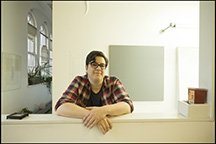 In a recent interview, Jennifer Williams A’94 stated matter of factly, “No one knows what photography is anymore.” She is not throwing a polemical bomb; she is making a statement of fact, gleaned from her work as co-head technician and adjunct professor of photography.
In a recent interview, Jennifer Williams A’94 stated matter of factly, “No one knows what photography is anymore.” She is not throwing a polemical bomb; she is making a statement of fact, gleaned from her work as co-head technician and adjunct professor of photography.
Williams’ photographs frequently show what planners call “the street wall”—the facades of buildings along a particular corridor—that she arranges in site-specific collages. Her work as an undergraduate at The Cooper Union, though focused on film and sculpture, was not a far cry from her current practice. “An understanding of those systems [of film and sculpture] is in there. I work with time—it’s very cinematic.”
She points out in her artist’s statement that she has no intention of stopping time with her photography. Instead, she’s interested in controlling the passing of time. “My work engages traditional photographic languages while simultaneously questioning its ‘truth dimension,’ exploiting photography’s ability to represent both what is true and what is false simultaneously.”
While the objectivity of photography has been called into question for years by artists and historians alike, Williams’ work addresses the medium’s unreliability in a particularly physical way: her collages of buildings are often large and arranged in a way that makes them seem three-dimensional. Structures about structures, they are at once a tromp l’oeil of the brick-and-mortar real thing and a wild rendition of street life, as if a detonated bomb had upended and rearranged the scene. The vividness of the collages is furthered by their very careful placement. A set of her collages was installed at the Queens Museum in the room with the famous model of every building in New York City that was created for the 1964 World’s Fair and updated every ten years. Her show, New York: City of Tomorrow, includes collages of new skyscrapers extending out from islands of smaller buildings. They appear to be tethered to an older New York but hardly of it.
As a technician and instructor at Cooper, she’s noticed a sea change over this past year: “Now first-year students know nothing about film and film cameras. Film did so much work for you.” She explains that different film brands and speeds had different qualities—Kodak Portra 400, say, for accurate rendering of skin tone, or Fuji Reala 100 for its fine grain, low contrast, and high saturation. Today, photographers shoot digitally and then process later to get the desired effects, an added step not needed with the right film.
As a resident of the Lower East Side for more than 20 years, Williams witnessed an enormous transformation of the neighborhood. She keeps a blog of photographs of the apartment where she lived, which, like her other work, is a form of analyzing space but on a smaller, more personal scale.
The volatile quality of her work isn’t an accident: Williams considers the remarkable and unrelenting forces of New York real estate as powerful, and potentially dangerous, as any physical explosion. She is, of course, well aware of the debates around gentrification and office construction-booms, but she wants her photography to provoke more than the usual arguments: “Whatever you think New York City is, this is what it is. Visualizing a neighborhood’s present state highlights the forces behind new building construction and questions how public spaces are being organized.”

